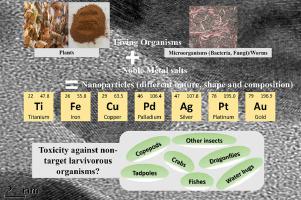Acta Tropica ( IF 2.1 ) Pub Date : 2020-12-11 , DOI: 10.1016/j.actatropica.2020.105792 Loick P. Kojom Foko , Francois Eya'ane Meva , Carole E. Eboumbou Moukoko , Agnes A. Ntoumba , Wolfgang E. Ekoko , Philippe Ebanda Kedi Belle , Gildas P. Ndjouondo , Godlove W. Bunda , Leopold G. Lehman

|
Studies capturing the high efficiency of green-synthesized metal nanoparticles (NPs) in targeting mosquito vectors of the world's main infectious diseases suggest the NPs’ possible utilization as bio-insecticides. However, it is necessary to confirm that these potential bio-insecticides are not harmful to non-target organisms that are often sympatric and natural enemies of the vectors of these diseases. In this systematic review, we comprehensively analyse the content of 56 publications focused on the potentially deleterious effects of NPs on these non-target organisms. Current research on biosynthesised NPs, characterization, and impact on mosquito vectors and non-target larvivorous organisms is reviewed and critically discussed. Finally, we pinpoint some major challenges that merit future investigation. Plants (87.5%) were mainly used for synthesizing NPs in the studies. NPs were found to be spherical or mainly spherical in shape with a large distribution size. In most of the included studies, NPs showed interesting mosquitocidal activity (LC50 < 50 ppm). Some plant families (e.g., Meliaceae, Poaceae, Lamiaceae) have produced NPs with a particularly high larvicidal and pupicidal activity (LC50 < 10 ppm). Regarding non-target organisms, most of the studies concluded that NPs were safe to them, with boosted predatory activity in NP-treated milieu. In contrast, some studies reported NP-elicited adverse effects (i.e., genotoxic, nuclear, and enzymatic effects) on these non-target organisms. This review outlines the promising mosquitocidal effects of biosynthesized NPs, recognizing that NPs’ potential usage is currently limited by the harm NPs are thought pose to non-target organism. It is of utmost importance to investigate green NPs to determine whether laboratory findings have applications in the real world.
中文翻译:

用于蚊子控制的绿色合成金属纳米颗粒:关于其对非目标生物的毒性的系统综述
捕获绿色合成金属纳米颗粒(NPs)的高效率靶向世界主要传染病的蚊媒的研究表明,NPs可能被用作生物杀虫剂。但是,有必要确认这些潜在的生物杀虫剂对通常是这些疾病媒介的同伴和天敌的非目标生物无害。在本系统的综述中,我们全面分析了56篇出版物的内容,这些出版物的重点是NP对这些非靶标生物的潜在有害作用。审查和批判性讨论了有关生物合成的NP,表征及其对蚊媒和非目标幼虫生物的影响的最新研究。最后,我们指出了一些值得进一步研究的重大挑战。植物(87。5%)主要用于研究中的NP合成。发现NP为球形或主要为球形,分布尺寸大。在大多数纳入研究中,NPs显示出有趣的灭蚊活性(LC50 <50 ppm)。一些植物科(例如,Meliaceae,Poaceae,Lamiaceae)产生的NP具有特别高的杀幼虫和杀螨活性(LC 50 <10 ppm)。关于非靶标生物,大多数研究得出结论,NP对它们是安全的,在NP处理的环境中掠食性活动增强。相反,一些研究报道了NP引起的对这些非目标生物的不利影响(即遗传毒性,核和酶促作用)。这篇综述概述了生物合成的NP的有希望的灭蚊作用,认识到NP的潜在用途目前受到NP危害非目标生物的限制。最重要的是调查绿色NP,以确定实验室发现是否在现实世界中有应用。











































 京公网安备 11010802027423号
京公网安备 11010802027423号